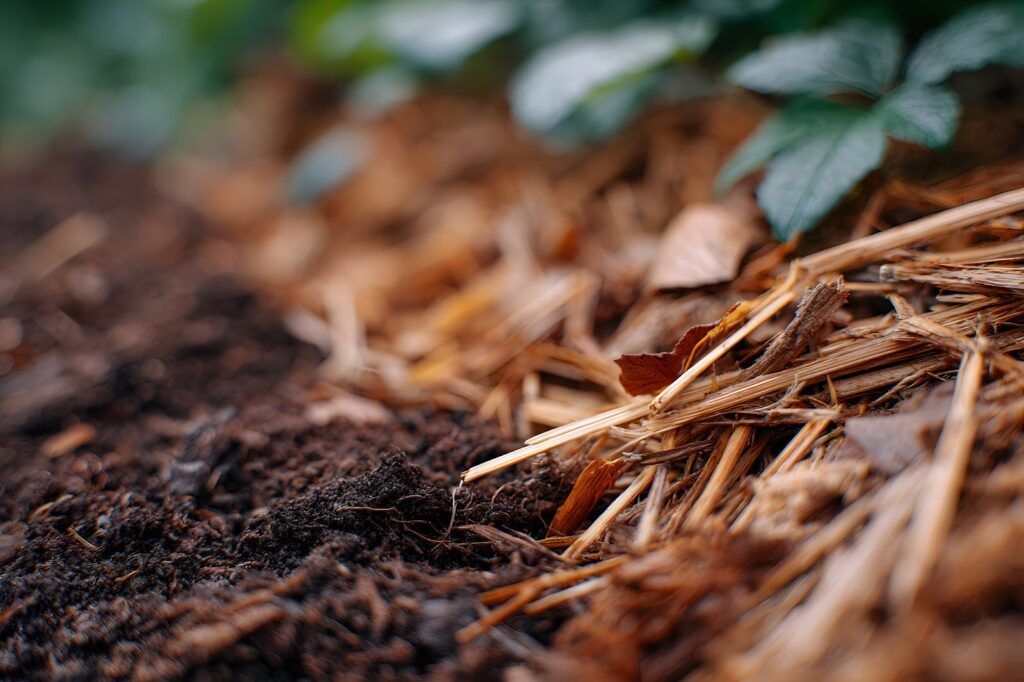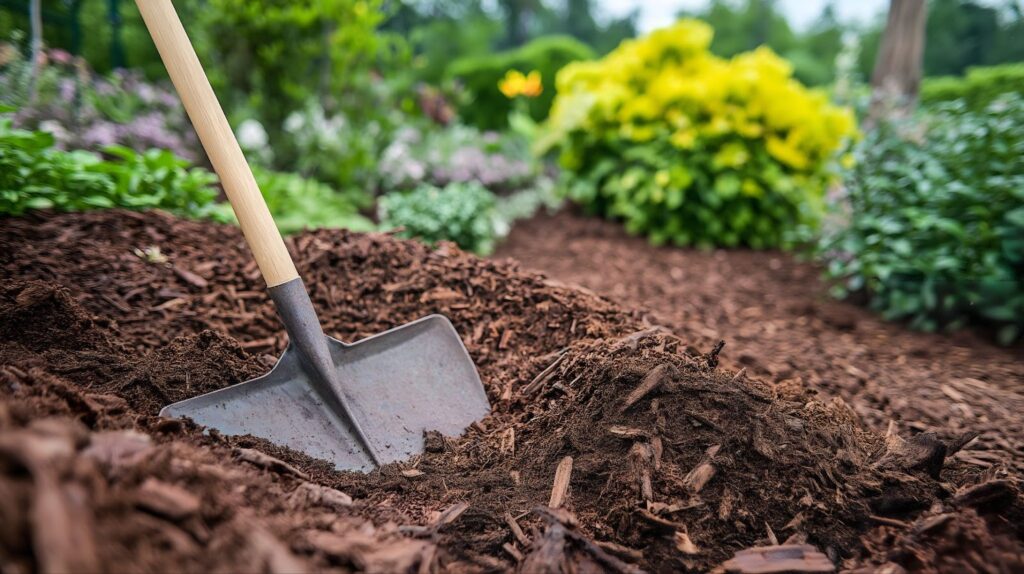Mulch prepping strengthens your landscape’s health and appearance. It creates a protective layer that insulates soil, locks in moisture, suppresses weeds, and boosts curb appeal. This barrier helps regulate soil temperature, prevent erosion, and support deeper, stronger root systems throughout the year, making your garden more resilient in every season.
This blog explains how to prep mulch for all four seasons. You’ll learn which mulch types perform best in specific conditions, how to apply them properly, and what seasonal strategies keep your garden thriving. Whether you care for flower beds, trees, or vegetable gardens, these mulch prepping tips will help you create a vibrant, resilient landscape all year long.
Why mulch matters year-round
Mulch supports healthy soil and vibrant plants through every season. It provides consistent protection and nourishment, keeping your garden resilient in the face of temperature shifts, rainfall fluctuations, and weed invasions.
Regulates soil temperature
Mulch acts as a natural insulator. In winter, it shields roots from freezing temperatures. In summer, it blocks direct sunlight and keeps the soil cooler. This steady environment helps roots grow stronger and reduces plant stress, regardless of season.
Retains moisture and suppresses weeds
Mulch locks in moisture by reducing evaporation from the soil surface. This reduces watering needs during dry spells and helps maintain soil hydration during unexpected hot days in spring or fall. At the same time, mulch blocks light from reaching weed seeds, preventing them from germinating and spreading.
Protects roots and builds better soil
Mulch reduces erosion and prevents compaction by creating a buffer between the elements and plant roots. As organic mulch breaks down, it enriches the soil with nutrients and encourages beneficial microbial activity. The improved structure promotes better drainage, aeration, and root penetration.
Enhances curb appeal and controls erosion
Beyond function, mulch creates clean, tidy lines around flower beds, trees, and pathways. It adds contrast and depth to your landscape design. During heavy rains, mulch slows runoff and holds soil in place, especially on slopes or in raised beds.
Spring mulch prepping
Spring signals a fresh start for your garden, and mulch prepping early sets the stage for strong growth throughout the season. After months of winter dormancy, your soil and plants need support to bounce back, and mulch plays a key role in that recovery.
Clear out winter debris and old mulch
Start by removing any remaining mulch that appears compacted, moldy, or discolored. This includes broken-down organic matter, fallen leaves, and leftover plant debris from the previous season. Clearing this material improves airflow and prevents fungal issues as temperatures warm.
Refresh with nutrient-rich mulch
Once you’ve cleaned the beds, add a new layer of mulch to restore moisture retention and support plant health. Use 2 to 3 inches of fresh mulch to protect emerging shoots and suppress weeds before they spread. Apply it evenly, without crowding plant stems or trunks.
Choose the best mulch for spring
Select mulch that nourishes the soil while controlling weeds and moisture loss. Compost offers a rich source of nutrients ideal for garden beds. Shredded leaves provide a lightweight and free option, while bark mulch delivers a clean look and long-lasting coverage. All three possibilities support early-season growth without overwhelming delicate roots.
Time your mulch application wisely
Wait until the soil warms up before mulching. If you apply mulch too early, you risk sealing in the cold and slowing root development. Aim to mulch after the final frost, once daytime temperatures stabilize and the soil feels cool but not icy to the touch.
Summer mulch strategies
Summer brings intense heat, longer daylight hours, and unpredictable rain patterns, which challenge your landscape’s ability to retain moisture and protect plant roots. A thoughtful approach to summer mulching preserves soil health, reduces water waste, and keeps your garden thriving through the hottest months.
Replenish mulch to lock in moisture
Summer heat accelerates evaporation, drying out the soil and stressing plants. Add a fresh 2- to 3-inch layer of mulch where coverage looks thin or bare. This insulates the soil and slows moisture loss, especially in exposed areas like flower beds, vegetable gardens, and tree bases.
Choose light-colored mulch for temperature control
Select mulch that reflects sunlight instead of absorbing it. Straw, shredded leaves, or pale bark help reduce surface temperatures and prevent heat from radiating back into plant roots. This simple color adjustment shields delicate root systems from heat stress and sunscald.
Maintain the right depth to support root health
Keep mulch layers between 2 and 4 inches deep. Too little mulch fails to provide adequate insulation, while too much may trap excess moisture or block airflow. Consistent depth helps stabilize soil temperature and minimize evaporation without suffocating roots or encouraging rot.
Monitor for compaction and fungal growth
High humidity and summer rains may cause mulch to clump, compact, or grow mold. Check your mulch regularly and use a rake to loosen compacted areas. If you spot mold, remove the affected portion and let the soil dry before adding a fresh layer. Proper air circulation within the mulch layer prevents fungal growth and improves water absorption.
Fall mulching tips

Fall sets the stage for winter survival and spring success in your garden. Proper mulching during this season strengthens plant roots, shields soil from temperature extremes, and prepares the landscape for the months ahead. Adjusting your mulch routine in autumn protects your investment and enhances garden performance year-round.
Prepare perennials and shrubs for colder months
Before applying mulch, trim back perennials and remove spent foliage. Cut back dead stems and clear out debris to prevent pests and disease from overwintering in your beds. Water deeply to hydrate roots before the ground freezes, ensuring plants go into dormancy with adequate moisture. This foundation supports healthier spring growth.
Apply mulch after the first frost
Wait until the first frost arrives before applying fall mulch. Frost signals plants to enter dormancy. Once that happens, spread a fresh 2- to 4-inch layer of mulch around the base of shrubs, trees, and perennials. This insulates the soil and stabilizes root zone temperatures during freeze-thaw cycles, which reduces the risk of heaving and root damage.
Choose the best mulch for autumn protection
Select materials that provide good insulation while allowing moisture and air to reach the soil. Straw, pine needles, and shredded bark work especially well in the fall. These options resist compaction and decompose slowly, offering long-lasting protection through winter. Pine needles also lock together naturally, staying in place even during high winds or heavy snow.
Avoid smothering plant crowns and tree trunks
When mulching in fall, leave space around the base of plants and trees. Keep mulch 2 to 3 inches away from trunks and crowns to prevent rot and disease. Piling mulch too close traps moisture against the bark and invites pests, fungi, and decay. Instead, create a donut-shaped ring around the base to provide insulation while keeping stems dry and healthy.
Winter mulch considerations
Winter mulch plays a critical role in protecting plant roots from harsh temperatures and fluctuating weather conditions. When temperatures drop, roots become vulnerable to freeze damage, especially during freezing and thawing cycles.
Thoughtful mulching provides insulation, prevents soil heaving, and encourages healthy plant survival through the coldest months.
Insulate roots with coarse materials
In winter, use coarse mulch materials to trap heat and provide stable insulation. Wood chips, bark nuggets, and pine needles work especially well because they resist compaction and maintain airflow while shielding the root zone. These materials create a natural barrier stabilizing soil temperature and minimizing root exposure to freezing air.
Apply mulch after the ground freezes
Wait until the ground begins to freeze before spreading winter mulch. Applying it too early may trap heat and delay dormancy, which weakens plants over time. Once the soil cools, add a layer of mulch about 3 to 4 inches deep around the base of perennials, shrubs, and trees. This timing ensures your plants rest during winter while benefiting from the protective barrier.
Check mulch after storms
Winter storms often scatter mulch or expose bare patches of soil. Inspect your garden after strong winds or heavy snow and reapply mulch where needed. Maintain consistent coverage, especially over vulnerable root zones, to prevent temperature shock and erosion caused by runoff or shifting ice.
Monitor for pests in warm mulch beds
Mulch retains warmth, which may attract rodents or insects seeking shelter. Regularly check under thick mulch for signs of burrowing or nesting. Look for chewed bark, droppings, or disturbed soil near plant bases. If you notice pest activity, gently remove the affected area, refresh it with clean material, and avoid piling mulch directly against trunks or stems.

Keep your landscape beautiful year-round with help from LaytonScape
If you’re ready to simplify your seasonal mulch routine or want to improve your landscape’s overall health and appearance, LaytonScape offers expert mulch installation tailored to your garden’s specific needs. Our team selects the best mulch and the right materials, applies them carefully, and ensures your outdoor space thrives every season.
Contact LaytonScape today to schedule your professional mulch service and enjoy a garden that looks great and grows strong all year long.

